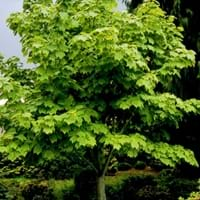Life Span
Perennial
Perennial
Origin
Europe, Asia
Northeastern United States, Mid-Atlantic United States, Southeastern United States, Canada
Types
Bigleaf hydrangea, Hortensia, Smooth hydrangea, Oakleaf hydrangea, Annabelle
Not Available
Number of Varieties
Not Available
Habitat
Forest edges, Hillside, Woods
moist forests, Slopes
USDA Hardiness Zone
Not Available
3-7
Sunset Zone
21,22
Not Available
Habit
Spreading
Upright/Erect
Flower Color
White, Purple, Pink, Violet, Ivory
Yellow, Yellow green
Flower Color Modifier
Bicolor
Bicolor
Fruit Color
Not Available
Green, Brown
Leaf Color in Spring
Green, Gray Green
Light Green
Leaf Color in Summer
Green, Gray Green
Green
Leaf Color in Fall
Green, Gray Green
Yellow
Leaf Color in Winter
Light Green
Not Available
Leaf Shape
Oblovate
Maple shaped
Plant Season
Spring, Summer
Not Available
Sunlight
Full Sun, Partial Sun, Partial shade
Partial Sun, Partial shade
Type of Soil
Clay, Loam
Loam
The pH of Soil
Acidic, Neutral
Acidic, Neutral
Soil Drainage
Average
Well drained
Bloom Time
Spring, Summer
Early Spring, Spring
Tolerances
Drought
Not Available
Where to Plant?
Container, Ground
Ground
How to Plant?
Seedlings, Stem Planting
Layering, Seedlings, Stem Cutting
Plant Maintenance
Medium
Medium
Watering Requirements
Not Available
Requires regular watering
In Summer
Average Water
Lots of watering
In Spring
Moderate
Moderate
In Winter
Average Water
Average Water
Soil pH
Acidic, Neutral
Acidic, Neutral
Soil Type
Clay, Loam
Loam
Soil Drainage Capacity
Average
Well drained
Sun Exposure
Full Sun, Partial Sun, Partial shade
Partial Sun, Partial shade
Pruning
Remove damaged leaves, Remove dead branches, Remove dead leaves
Prune if you want to improve plant shape
Fertilizers
All-Purpose Liquid Fertilizer
All-Purpose Liquid Fertilizer
Pests and Diseases
Red blotch
Anthracnose, Bacterial leaf scorch, Bleeding canker, Decline, Fomes root rot, Ganoderma root rot, Laetiporus root rot, Leaf spot, Powdery mildew, Red blotch, Tar spot, Verticillium Wilt
Plant Tolerance
Drought
Drought
Flowers
Showy
Insignificant
Flower Petal Number
Single
Single
Foliage Texture
Coarse
Coarse
Foliage Sheen
Matte
Matte
Attracts
Bees, Flies
Not Available
Allergy
Chest tightness, Diarrhea, Dizziness, Nausea, Vomiting
Asthma, Runny nose, Skin irritation
Aesthetic Uses
Not Available
Showy Purposes
Beauty Benefits
Not Available
Not Available
Edible Uses
Not Available
Yes
Environmental Uses
Air purification
Air purification
Medicinal Uses
Fever, Kidney problems, Urinary tract problems
Antirheumatic, Cold, Cough, Emetic, gonorrhoea, Kidney problems, Pectoral, Swelling, Vomiting
Part of Plant Used
Flowers, Root
Leaves, Sap
Other Uses
Not Available
Used as Ornamental plant, Used as preservative
Used As Indoor Plant
Not Available
No
Used As Outdoor Plant
Yes
Yes
Garden Design
Herb / Vegetable
Feature Plant
Botanical Name
SYMPHYTUM officinale
ACER pensylvanicum
Common Name
Common Comfrey
Moosewood, striped maple, moose maple
In Hindi
Hydrangea
धारीदार मेपल
In German
Hortensie
gestreifte Ahorn
In French
Hortensia
érable rayé
In Spanish
Hortensia
arce rayado
In Greek
υδραγεία
ριγέ σφενδάμου
In Portuguese
Hortênsia
plátano listrada
In Polish
Hortensja
paski klonu
In Latin
Hibiscus
alba acernis
Phylum
Not Available
Magnoliophyta
Class
Not Available
Magnoliopsida
Order
Not Available
Sapindales
Family
Boraginaceae
Aceraceae
Clade
Not Available
Angiosperms, Eudicots, Rosids
Tribe
Not Available
Not Available
Subfamily
Not Available
Not Available
Number of Species
Not Available
Not Available
Difference Between Common Comfrey and Moosewood Tree
If you are confused whether Common Comfrey or Moosewood Tree are same, here are some features about those plants to help you choose better. Many people think that these two plants have the same characteristics, but one can see Common Comfrey and Moosewood Tree Information and learn more about it. Fertilizers required for proper growth of Common Comfrey are All-Purpose Liquid Fertilizer, whereas for Moosewood Tree fertilizers required are All-Purpose Liquid Fertilizer. Hence, one should know the basic difference between Common Comfrey and Moosewood Tree if you are planning to have them in your garden to enhance its beauty.
<
Flowering PlantsImportance of Common Comfrey and Moosewood Tree
Want to have the most appropriate plant for your garden? You might want to know the importance of Common Comfrey and Moosewood Tree. Basically, these two plants vary in many aspects. Compare Common Comfrey and Moosewood Tree as they differ in many characteristics such as their life, care, benefits, facts, etc. Every gardener must at least have the slightest clue about the plants he wants to plant in his garden. Compare their benefits, which differ in many ways like facts and uses. The medicinal use of Common Comfrey is Fever, Kidney problems and Urinary tract problems whereas of Moosewood Tree is Antirheumatic, Cold, Cough, Emetic, gonorrhoea, Kidney problems, Pectoral, Swelling and Vomiting. Common Comfrey has beauty benefits as follows: Not Available while Moosewood Tree has beauty benefits as follows: Not Available.
Compare Facts of Common Comfrey vs Moosewood Tree
How to choose the best garden plant for your garden depending upon its facts? Here garden plant comparison will help you to solve this query. Compare the facts of Common Comfrey vs Moosewood Tree and know which one to choose. As garden plants have benefits and other uses, allergy is also a major drawback of plants for some people. Allergic reactions of Common Comfrey are Chest tightness, Diarrhea, Dizziness, Nausea and Vomiting whereas of Moosewood Tree have Asthma, Runny nose and Skin irritation respectively. Having a fruit bearing plant in your garden can be a plus point of your garden. Common Comfrey has no showy fruits and Moosewood Tree has no showy fruits. Also Common Comfrey is not flowering and Moosewood Tree is not flowering . You can compare Common Comfrey and Moosewood Tree facts and facts of other plants too.

